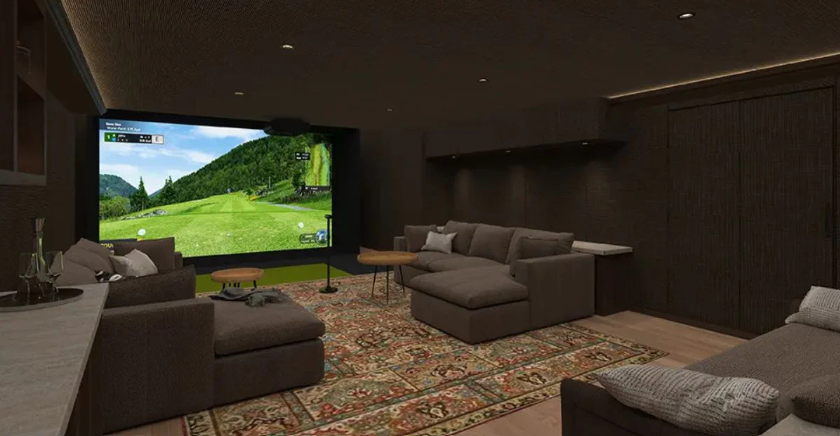Designing your own golf simulator setup at home sounds exciting—and it is. But between all the shiny tech, sales pitches, and conflicting online advice, it’s easy to get overwhelmed or overspend on features that won’t actually improve your game. Whether you’re aiming for a performance-focused practice space or a fun, immersive experience for the whole family, the key is knowing what matters most—and what doesn’t.
This guide cuts through the noise to help you build a smart, effective setup tailored to your goals, space, and budget.
Start With a Clear Plan: Know Your Space and Purpose
Think Beyond Just the Equipment
Before diving into product options, evaluate your available space. This includes ceiling height, room width, and floor depth. A full swing with a driver typically requires 9–10 feet of ceiling clearance and at least 12 feet of depth to allow for proper tracking and safety.
Next, clarify your goals. Are you training for performance? Looking for a fun entertainment system for the family? Or blending both? Your priorities will directly influence what type of system and accessories make the most sense for your build.
What You Actually Need in a Golf Simulator for Home
1. Accurate Tracking System
This is the heart of your setup. The tracking system measures ball speed, launch angle, spin, and club data. The most reliable options use radar, camera-based sensors, or a hybrid of both to deliver detailed feedback with minimal delay.
If you’re serious about getting the most value out of your golf simulator for home, start with a high-quality tracking unit. It ensures every swing translates into actionable insights that help improve your game—not just pretty graphics on a screen.
2. High-Quality Hitting Mat
This is one of the most overlooked but important pieces of your simulator. A poor-quality mat can cause joint strain or provide inaccurate turf feedback. Look for one with realistic turf feel and sufficient shock absorption.
If you plan to hit frequently or use various clubs, consider upgrading the mat—even if your package includes a basic one.
3. Impact Screen and Enclosure
The screen you hit into should be able to withstand thousands of shots while displaying clear, crisp visuals. Reinforced screens with minimal bounce-back are best for both safety and performance.
An enclosure adds a layer of professionalism and safety by containing errant shots. Make sure the frame and netting are durable and sized appropriately for your space.
4. Projector and Mounting
While not technically required for swing data, a projector enhances the visual experience by displaying a simulated course or range on the impact screen. For immersive play, use a short-throw projector mounted either overhead or behind the hitting zone to minimize shadows and maximize screen coverage.
Make sure your projector supports the resolution of your simulation software and is bright enough for indoor environments.
5. Simulation Software
A robust software package transforms data into actionable insight. It should include practice ranges, virtual course play, shot analysis tools, and skill challenges. Some systems offer multiplayer modes and course libraries from around the world.
The software you choose will define how dynamic and realistic your golf simulator for home feels—not just in terms of graphics, but also in how effectively it replicates real-world conditions and feedback.
What to Skip (Or Postpone) When Building Your Setup
Fancy Club Racks and Decor
While nice to look at, premium club racks, lighting systems, or custom cabinetry can add hundreds or even thousands to your build without improving your game. If you’re working within a budget, focus on performance-related components first. A simple stand or wall-mounted rack will do the job.
Overpriced Launch Monitors for Beginners
Not every golfer needs the most advanced launch monitor on the market. Many high-end models offer granular data that only low-handicap or competitive players will fully utilize. For casual users or beginners, a more affordable yet reliable model can still deliver excellent feedback without the steep learning curve.
Unnecessary Software Subscriptions
Some platforms charge extra for premium features or course libraries. Be sure to evaluate whether these extras truly add value based on how often you’ll use them. It’s easy to get excited by all the features during purchase but end up rarely using them.
Overbuilding for Entertainment
It’s tempting to turn your simulator into a media room, but extras like surround sound systems or luxury seating don’t affect practice quality. If your primary purpose is golf training, invest more in core performance components before expanding into lifestyle upgrades.
Smart Extras Worth Considering
Net and Turf Extension
Adding a turf extension in front of your hitting mat provides a continuous putting surface and helps with visual alignment. It also protects your floor and enhances the aesthetic.
A safety net can prevent damage to walls or ceilings from off-line shots, especially in shared spaces like garages or basements.
Lighting
Proper lighting helps tracking systems perform more accurately and makes the space feel more comfortable. Use soft, directional lights that don’t create glare or interfere with sensors.
Tablet or Mobile Stand
A hands-free stand for your tablet or smartphone allows you to easily review swing data or control your simulator software. It’s a small detail that makes a big difference during sessions.
Expert Tips for a Seamless Setup
Calibrate and Test Everything
Don’t just plug and play. Take time to properly calibrate your tracking system, test screen tension, and align your projector. Small setup errors can lead to major accuracy issues or visual misalignment.
Keep the Area Clutter-Free
A clean, open space minimizes distractions and reduces the chance of damage to equipment. Keep loose clubs, bags, and furniture out of the swing zone.
Plan for Upgrades
Your first build doesn’t have to be perfect. Focus on essentials now, and leave room—literally and financially—for future upgrades like better lighting, enhanced software, or more advanced monitors.
Conclusion
A well-designed home simulator setup isn’t about having the most expensive gear—it’s about choosing smart, functional components that fit your space and your goals. By focusing on core performance features and skipping unnecessary extras, you can build a golf environment that helps you play better, practice more often, and enjoy the game in a whole new way.





